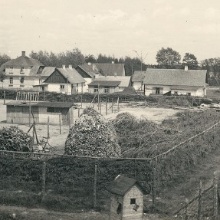As part of a press conference and an event held at the “Topography of Terror” documentation center, historians from the Ludwigsburg Research Center at the University of Stuttgart and the Bildungswerk Stanislaw Hantz e.V. educational organization presented the Niemann collection regarding the Holocaust and National Socialism entitled “Photos from Sobibor” to the public in Berlin on 28 January 2020. More than 350 photos and written sources have recently been discovered which once belonged to Johann Niemann, the deputy commander of the Sobibor extermination camp. The pictures, which were from Niemann’s private collection, give us a new and very visual insight into the Holocaust in German-occupied Poland and on the killing of sick people as “euthanasia”.
The Niemann collection makes a valuable contribution to understanding the murder of around 1.8 million Jewish people, particularly in the Sobibor, Belzec and Treblinka death camps, which was known as “Operation Reinhard”. Putting the sources into a historical context, the Director of the Ludwigsburg Research Center, Dr. Martin Cüppers, said: “The photo collection which was recently discovered represents a giant leap forward in the way the story of the Holocaust in German-occupied Poland can be told in visual form. The collection provides significant historical insights into how the responsibilities for implementing mass murder developed and into who was responsible for the crimes against humanity which took place under the Nazis.”
“Whereas before only two photos of the Sobibor death camp were known to exist which were taken at the time when it was an extermination camp, now 49 photos from the Niemann collection give the history of Sobibor much more of a visual dimension and greatly increase our understanding of what happened”, underlined Steffen Hänschen, historian at the Bildungswerk Stanislaw Hantz.
The new findings from the Niemann collection also shed light on another aspect: At the beginning of the mass crimes the Nazis were breaking completely new ground, because no civilized society had ever cast their humanity aside like that before. This is when individuals at the lower levels in the hierarchy became more significant. “Proactive Nazi perpetrators such as Niemann in Belzec were given an astonishing amount of room for maneuver, which enabled them to develop and test out new ways of murdering people. Once these methods had been shown to work in practice, it became possible to take the killings to a whole new level. The command and obey approach which had been dominant before became less important”, said Cüppers.
The Niemann collection has since been given to the archives of the United States Holocaust Memorial Museum (USHMM) in Washington.
About the Ludwigsburg Research Center at the University of Stuttgart
It was founded in 2001 as part of the Department for Modern History at the University of Stuttgart, and analyses the mass crimes committed in the National Socialist era and the Holocaust in particular. It regularly publishes books on its findings in order to reach a wider public. Alongside its main focus on the individuals responsible for the mass crimes committed during the Third Reich, its activities also include the sociopolitical attempts to understand the crimes in the post-war era as well as the criminal trials which were held. Additional information (in German) can be found at this page.
About the Bildungswerk Stanisław Hantz e. V.
Since 1995, the Bildungswerk Stanisław Hantz e. V. educational organization has focused on keeping the memory of the Holocaust alive through educational trips to the various places in Central and Eastern Europe where the Holocaust took place. The organization is named after a survivor of the Auschwitz-Birkenau extermination camp, so it is strongly associated with Auschwitz in particular. However, it also tries to raise awareness of the more “forgotten” and “unknown” places, and organizes projects in Poland, Lithuania and Ukraine. Additional information (in German) can be found at this page.
Expert Contact:
Dr. Martin Cüppers, Wissenschaftlicher Leiter der Forschungsstelle Ludwigsburg der Universität Stuttgart, Mail


